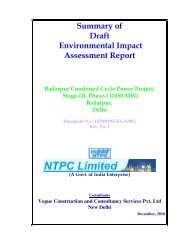350 MW Pragati-II Combined Cycle Power Project of PPCL
350 MW Pragati-II Combined Cycle Power Project of PPCL
350 MW Pragati-II Combined Cycle Power Project of PPCL
- No tags were found...
You also want an ePaper? Increase the reach of your titles
YUMPU automatically turns print PDFs into web optimized ePapers that Google loves.
Rapid Environmental ImpactAssessment Study <strong>of</strong> the Proposed<strong>350</strong> <strong>MW</strong> <strong>Pragati</strong>-<strong>II</strong> <strong>Combined</strong> <strong>Cycle</strong><strong>Power</strong> <strong>Project</strong> <strong>of</strong> <strong>PPCL</strong>Doc. No.: CW-EN-9384-C-379-E-R-002Rev. No.: R0Issue Date: 21-02-2006Page No: 12 <strong>of</strong> 16control measures such as paving and surface treatment, water sprinkling andplantation schemes. So, there will be positive impact.There is only one major gaseous pollutant NOx. As DLN burners shall beincorporated to reduce the formation <strong>of</strong> NOx, long-term incremental ground levelconcentration <strong>of</strong> NOx in the study area due to plant operation will be very low. Thus,impact <strong>of</strong> the emissions on terrestrial ecosystems would be insignificant.11.7 AQUATIC ECOLOGYThe run<strong>of</strong>f from construction area will be discharged through a catchments pit/-settling pond, thereby reducing suspended solids in stream water run<strong>of</strong>f andreduction in possibilities <strong>of</strong> sedimentation at river/water bed. Although, during heavyrainfall in monsoon months, Yamuna is generally flooded and carry significantconcentration <strong>of</strong> suspended solids from catchment area. Thus, the impact <strong>of</strong>construction activities on aquatic ecology <strong>of</strong> Yamuna River is likely to be insignificant.<strong>Pragati</strong> <strong>II</strong> CCPP will not draw any water from Yamuna river, which is natural waterbody.Further, as the project will have a close cycle cooling system with cooling towers,there will be no thermal impact on aquatic ecosystem due to operation <strong>of</strong> the plant.Secondly all the effluent will be treated before discharge into the drain joiningYamuna River.11.8 NOISEThe major noise generating sources during the construction phase are vehiculartraffic, construction equipments like, dozer, scrapers, concrete mixers, cranes,generators, pumps, compressors, rock drills, pneumatic tools, vibrators etc. Theoperation <strong>of</strong> these equipment will generate noise ranging between 75 – 90 dB (A).The predicted noise level due to operation <strong>of</strong> such equipment at a distance <strong>of</strong> 1.5 kmfrom the source is 23.9 dB(A).The ambient noise level recorded during field studies in the near by area <strong>of</strong> the siteranges between 20.0 – 60.2 dB(A). As the ambient noise levels are higher than thepredicted noise levels, due to masking effect, no increase in the ambient noise levelsduring construction phase is envisaged.Thus, there would not be any adverse impact due to construction and operation <strong>of</strong>the plant on the noise level <strong>of</strong> the surrounding area.12.0 ENVIRONMENTAL MANAGEMENT PLAN12.1 CONSTRUCTION PHASE• During construction phase, water shall be sprinkled in the vulnerable areas tosuppress the dust generated during excavation, leveling and other operations.• The effluents from construction area shall be channeled through sedimentationtanks to remove suspended solids.EXECUTIVE SUMMARYMANTEC CONSULTANTS (P) LTD., NEW DELHI
















